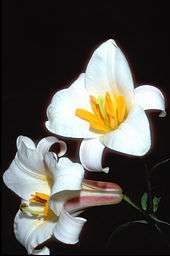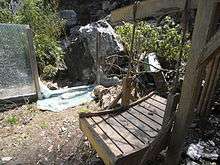Wolong National Nature Reserve
| Wolong National Nature Reserve | |
|---|---|
|
Panda cub at the panda breeding centre of Wolong Nature Reserve | |
 | |
| Location | Wenchuan County, Sichuan Province, People's Republic of China |
| Nearest city | Chengdu |
| Coordinates | 31°01′N 103°06′E / 31.02°N 103.10°E[1]Coordinates: 31°01′N 103°06′E / 31.02°N 103.10°E[2] |
| Area | c. 2,000 km2 (770 sq mi) |
| Established | 1963 |
Wolong National Nature Reserve (simplified Chinese: 卧龙自然保护区; traditional Chinese: 臥龍自然保護區; pinyin: Wòlóng Zìránbǎohùqū) is a protected area located in Wenchuan County, Sichuan Province, People's Republic of China. Established in 1963 with an initial size of about 20,000 hectares, the reserve was further expanded in 1975, covering an area of about 200,000 hectares in the Qionglai Mountains region. There are over 4,000 different species recorded in the reserve.[3] According to China's Third National Giant Panda Survey, Wolong National Nature Reserve houses about 150 wild individuals of highly endangered giant pandas. The reserve is also a home to many other endangered species including: snow leopards, red pandas, golden monkeys, white-lipped deer and many precious plants. Before the devastating 2008 Wenchuan Earthquake Wolong gets up to 200,000 visitors every year. [4][5] Its area is superseded by the Wolong Special Administrative Region.
Background
In June 1980, the China Conservation and Research Center for the Giant Panda was established at Wolong with the efforts of both World Wildlife Fund (WWF) and the Chinese government. To this date, researchers have conducted many breeding research projects on giant pandas and have successfully bred 66 panda cubs.[3]
Location

A mountain stream runs through the Wolong Valley (where the reserve is); the stream is heavily armoured with boulders and smaller rounded stones. Stream waters are rather alkaline with pH levels in the range of 8.91. (Hogan, 2007) Water quality turbidity is quite high due to extensive sand and gravel mining in stream.[6]
According to a 2001 research by Dr. Jianguo Liu of Michigan State University, the rate of destruction is higher after the reserve's creation than before its creation.[7] Using NASA's satellite images and records of population, Liu's research team concluded that due to tourism and the increase in local population, the reserve is facing an unprecedented threat. "Tourists don't think they have an impact on panda habitat, but indirectly each visitor has some impact," Liu said. "We don't see ourselves as a destructive force, but we are."[8]
Fauna
The giant panda is the most famous species of the reserve. Other typical larger Carnivora are North-Chinese leopards, Ussuri dholes, Asian black bears, Asiatic golden cats, red pandas, hog badgers and yellow-throated martens. Hooved mammals are represented by Sichuan takins, wild boar, musk deer, mainland serows, Chinese gorals, tufted deer and sambar deer. Other noticeable mammals include golden snub-nosed monkeys, Tibetan macaques, complex-toothed flying squirrels, bamboo rats, and porcupines.[9] Because the reserve comprises different altitudes, it includes tropical and temperate climate zones and harbors species typically for the tropics, like clouded leopards and sambar deer as well as species from temperate regions, like white-lipped deer, snow leopards and Turkestan lynxes.[10]
2008 Earthquake

The region, including the Panda Research Center, was largely devastated on May 12, 2008, by a catastrophic earthquake, though the captive giant pandas were initially reported to be safe.[11][12] Immediately after the quake, officials were unable to contact the reserve.[13] PRC’s Foreign Ministry later said that a group of 31 British tourists visiting the Wolong panda reserve in the quake-hit area returned safe and uninjured to the provincial capital. The well-being of an even greater number of pandas in the neighbouring panda reserves initially remained unknown. Five security guards at the reserve were killed by the earthquake.[14] Six pandas escaped after their enclosures were damaged. By May 20, two pandas at the reserve were found to be injured, while the search continued for another two adult pandas that went missing after the quake.[15] By May 28, 2008, one panda was still missing,[16] nine-year-old Mao Mao, a mother of five at the breeding centre. She was discovered on Monday, June 9, her body crushed by a wall in her enclosure.[17] Panda keepers and other workers placed her remains in a small wooden crate and buried her outside the breeding centre.
For the time being the giant pandas have been relocated to the Bifengxia Panda Base, which is also managed by the China Panda Protection and Research Center.[18]
See also
- Wolong Special Administrative Region
- Bifengxia Panda Base
- Chengdu Research Base of Giant Panda Breeding
- Dengsheng
- Red panda
- Sichuan Giant Panda Sanctuaries
References
- ↑ "Shaumari Wildlife Reserve". protectedplanet.net.
- ↑ "Shaumari Wildlife Reserve". protectedplanet.net.
- 1 2 About Wolong, Wolong National Natural Reserve.
- ↑ Liu, Wei; Vogt, Christine A.; Luo, Junyan; He, Guangming; Frank, Kenneth A.; Liu, Jianguo (2012-04-25). "Drivers and Socioeconomic Impacts of Tourism Participation in Protected Areas". PLOS ONE. 7 (4): e35420. doi:10.1371/journal.pone.0035420. ISSN 1932-6203. PMC 3338832
 . PMID 22558149.
. PMID 22558149. - ↑ Liu, Wei; Vogt, Christine A.; Lupi, Frank; He, Guangming; Ouyang, Zhiyun; Liu, Jianguo (2016-02-01). "Evolution of tourism in a flagship protected area of China". Journal of Sustainable Tourism. 24 (2): 203–226. doi:10.1080/09669582.2015.1071380. ISSN 0966-9582.
- ↑ Hogan, C.M., Lumina Tech, Environmental analysis of the Wolong National Nature Reserve (2007)
- ↑ Liu, Jianuo, Marc Linderman, Zhiyun Ouyang, Li An, Jian Yang, and Hemin Zhang. "Ecological Degradation in Protected Areas: The Case of Wolong Nature Reserve for Giant Pandas." Science 292.5514 (2001): 98-101. Web. 18 Feb. 2016.
- ↑ (April 6, 2001) Endangered Pandas Not Safe in Chinese Nature Reserve, Environment News Service.
- ↑ Kenneth G. Johnson, Wang Wei, Donald G. Reid and Hu Jinchu: Food Habits of Asiatic Leopards (Panthera pardus fusea) in Wolong Reserve, Sichuan, China. Journal of Mammalogy. Vol. 74, No. 3 (Aug., 1993), pp. 646-650.
- ↑ William Riley, Laura Riley: Nature´s Strongholds. The World´s Great Wildlife Reserves. Princeton University Press, 2005. ISBN 0-691-12219-9
- ↑ (May 14, 2008). , Pandas International.
- ↑ (May 13, 2008). , Pandas 'safe' at park after quake.
- ↑ "Report: Rare giant pandas at Chinese breeding center safe after quake". International Herald Tribune. 2008-05-13. Retrieved 2008-05-20.
- ↑ Liu, Melinda (2008-05-21). "Animal Instinct". Newsweek. China Earthquake. Archived from the original on 2008-06-14. Retrieved 2008-06-10.
- ↑ "Two pandas missing in China quake region". UPI. 2008-05-20. Retrieved 2008-05-20.
- ↑ Associated Press (2008-05-29). "Panda reserve mulls moving after quake damage". CNN. Archived from the original on 2008-06-01. Retrieved 2008-05-29.
- ↑ Yan, Yangtze (2008-06-10). "One panda confirmed dead in China quake". Window of China. Xinhua News Agency. Retrieved 2008-06-10.
- ↑ Empty citation (help)
External links
| Wikimedia Commons has media related to Wolong National Nature Reserve. |